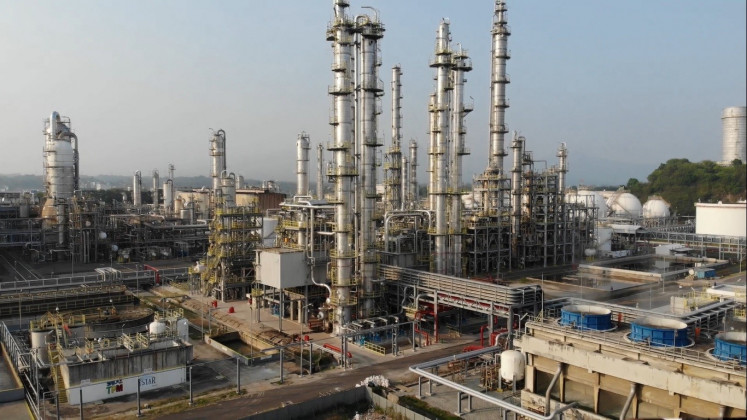Cut cancer patients’ waiting times, insurance deficit
Throughout February, many countries, including Indonesia, held festivals, walks, public information campaigns and other events to celebrate World Cancer Day, which the Union for International Cancer Control commemorated as important for intensifying various cancer management efforts
Change text size
Gift Premium Articles
to Anyone

T
hroughout February, many countries, including Indonesia, held festivals, walks, public information campaigns and other events to celebrate World Cancer Day, which the Union for International Cancer Control commemorated as important for intensifying various cancer management efforts. Public awareness is expected to be better, including in prevention, early detection and treatment of cancer.
The view for many decades that cancer is an incurable disease has turned out to be wrong. After being diagnosed with lymphoma in 1992 and declared cured, Singaporean Prime Minister Lee Hsien Loong underwent surgery for prostate cancer in February 2015 and is said to still have a life expectancy rate of 99 percent for the next 15 years.
In the United States and Europe, in the last 40 years, the survival rate among those with various types of cancer has increased sharply.
In the United Kingdom, breast cancer, the most common cancer in women, currently has a 10-year life expectancy rate of around 80 percent since the diagnosis was established, compared to only 40 percent in the early 1970s.
For prostate cancer, the main type of cancer in men, around 84 percent of sufferers are still alive 10 years after being diagnosed (compared to only 25 percent in 1970-1971). In America, in less than 30 years, the number of all types of cancer survivors who are still alive 10 years after diagnosis increased from around 40 percent to more than 60 percent, according to the 2010 US Surveillance, Epidemiology and End Results Program.
In children, bone marrow transplantation for acute leukemia can provide cure rates above 70 percent. Similar numbers have been seen in Japan and South Korea. All this data may be different from that recorded in Indonesia, where less than 20 percent of cancer patients are estimated to still be alive 10 years after diagnosis.
Have there been changes in the last 10 years of cancer management in Indonesia? Cancer is a growing social problem in many countries. The budget for the treatment of cancer under the national health insurance (JKN) scheme run by the Health Care and Social Security Agency (BPJS Kesehatan) is one that is increasing every year.
Cancer prevention and early detection programs carried out by the Health Ministry in the last 10 years have not provided optimal results, such as those already achieved in, for example, the Sarawak state of Malaysia. Most cancer patients here go to hospitals at an advanced stage, often requiring very expensive drugs.
The waiting time for BPJS Kesehatan patients seeking to get therapy and radiation treatment is still very long at three to six months — even in the capital. Some new cancer drugs that have proven effective and are commonly used in many other countries, even those on the List of Essential Medicines recommended by the World Health Organization (WHO), are often approved quite late. The ministry and BPJS Kesehatan also lack an audit system to ensure quality services for cancer patients. Such a system should include proper diagnosis with good facilities (radiology, pathology, laboratory), until, for example, there are special surgical procedures by trained and competent surgeons according to the standards of developed countries, the use of various types of cancer drugs and their combinations by oncologists, good multidisciplinary teams, radiotherapy facilities that are spread evenly in various regions and good palliative therapy.
To cut the growing funding deficit, BPJS Kesehatan tried to limit services for cataract patients, healthy babies and physiotherapy. For about eight months (April to December 2018), BPJS Kesehatan also stopped guaranteeing an essential breast cancer drug, trastuzumab, that has existed since the health insurance (Askes) era before the JKN period began in 2014, citing a report on survival data that cannot be verified.
Thousands of breast cancer patients in various regions throughout Indonesia have been harmed because they do not get the best treatment according to the national formulary (Fornas).
Following protests from various parties, including one patient lawsuit in a South Jakarta court, BPJS finally agreed to have the drug returned to the lists of those that it covers. Unfortunately, there has yet to be a statement of apology from the directors of BPJS for cancer patients and their families.
The Health Ministry has not conducted a cancer drug audit to answer whether the various “expensive” drugs under the JKN from 2014 to 2018 period adhere to various restrictions stipulated in the Fornas, such as with for cetuximab and bevacizumab for stage 4 colon cancer.
These colorectal cancer drugs will be removed from Fornas on March 1. For the future, more general provisions can be made for various stage 4 cancer drugs received by Fornas. The drugs should be included on the list of essential medicines suggested by WHO and only use drugs (or drug combinations) that can give a median survival above 30 months or a five-year survival rate above 30 percent.
Data from the Globocan in 2018 show Indonesia has around 348,000 new cancer patients every year — 58,000 patients of breast cancer, 30,000 of lung cancer and 30,000 of colon cancer — with 207,000 deaths from cancer. Spending trillions abroad, many of our patients continue to seek treatment in China, Malaysia and Singapore because they consider the quality of cancer treatment in Indonesia to lag behind other countries. This situation should improve if the government makes changes to the healthcare system.
More advanced regions, such as Jakarta, are actually able to provide good cancer treatment. In addition to Dharmais Cancer Hospital and Cipto Mangunkusumo Hospital, the government can establish several regional cancer centers in various parts of Jakarta. The success of cancer prevention programs in Jakarta, along with better services and treatment for tens of thousands of patients, will set the precedent for improving access and quality of services for cancer patients in other regions.
The new government, under whoever is elected president and appointed health minister for the period of 2019-2024, must be brave enough to set one public health status target when celebrating World Cancer Day in 2029: With a good prevention program, the right diagnosis and optimal therapy, Indonesia can achieve a minimum five-year survival rate of 50 to 60 percent for cancer patients.
______________________
The writer is an oncologist in Jakarta.









